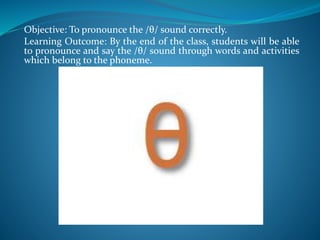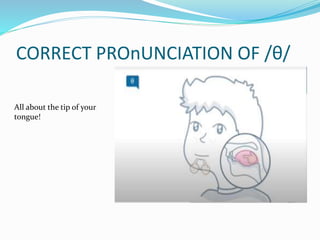Th sound
- 1. Objective: To pronounce the /¦È/ sound correctly. Learning Outcome: By the end of the class, students will be able to pronounce and say the /¦È/ sound through words and activities which belong to the phoneme.
- 2. WHY IS IT DIFFICULT FOR SPANISH SPEAKERS? Custom to the /d/ sound in Spanish. Voiceless and voiced.
- 3. EXAMPLES Not so difficult but confusing. Focused on how to pronounce correctly.
- 4. CORRECT PROnUNCIATION OF /¦È/ All about the tip of your tongue!
- 5. CORRECT PRonUNCIATION OF /¦È/ May touch the bootom of your upper front teeth
- 6. CORRECT PRONUNCIATION OF /¦È/ Blow air. Noise friction Upper teeth and your tongue Frinction in the stream of air.
- 7. LET¡¯S PRACTICE! The phoneme could be at the beginnign, middle or end.
- 8. IT¡¯S YOUR TURN TO PRACTICE! A reading and speaking exercise practicing the phoneme.
- 9. ? https://www.evaeaston.com/th-begin/ TEST YOURSELF After indetifying, practicing and pronouncing, there is a listening evaluation.









